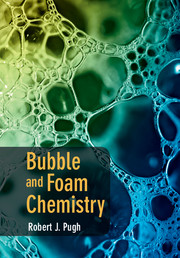Book contents
- Frontmatter
- Contents
- Preface
- Acknowledgments
- List of symbols
- 1 Basic principles and concepts
- 2 The nature and properties of foaming surfactants
- 3 Soap bubbles and thin films
- 4 Processes in foaming
- 5 Generation of bubbles and foams
- 6 Coalescence of bubbles in surfactant solutions
- 7 The stability/instability of bubbles and foams
- 8 Particle-stabilized foams
- 9 Foaming in non-aqueous liquids
- 10 Antifoaming and defoaming
- 11 Bubble size measurements and foam test methods
- 12 Bubble and foam chemistry - new areas of foam research
- Index
- References
2 - The nature and properties of foaming surfactants
Published online by Cambridge University Press: 05 September 2016
- Frontmatter
- Contents
- Preface
- Acknowledgments
- List of symbols
- 1 Basic principles and concepts
- 2 The nature and properties of foaming surfactants
- 3 Soap bubbles and thin films
- 4 Processes in foaming
- 5 Generation of bubbles and foams
- 6 Coalescence of bubbles in surfactant solutions
- 7 The stability/instability of bubbles and foams
- 8 Particle-stabilized foams
- 9 Foaming in non-aqueous liquids
- 10 Antifoaming and defoaming
- 11 Bubble size measurements and foam test methods
- 12 Bubble and foam chemistry - new areas of foam research
- Index
- References
Summary
Shampoo doesn't have to foam, but we add foaming chemicals because people expect it each time they wash their hair.
Quotescondex.comThe formation of self-assemblies from pre-micellar surfactant species
The adsorption of amphiphilic surfactant molecules at the bubble interface is not the only important phenomenon occurring during foam formation. Another extremely important process also occurs in bulk solution at high surfactant concentrations. This involves a spontaneous self-assembly process in which higher molecular structural aggregates or units of surfactant are formed from lower molecular weight pre-micellar species (monomer, dimer and trimer units). In the simplest case, this corresponds to the formation of a spherical micelle, and the transition concentration (of monomer) at which this occurs is called the “critical micelle concentration” (CMC). Marked changes in foaming behavior, as well as changes in electrical conductivity, surface tension, turbidity and uptake of organic dyes, occur in bulk solution above the CMC, but the molecular concentration of the surfactant in the water remains constant, with the surplus molecules forming additional micelles. Fig. 2.1 depicts the successive steps involved in the growth of the micelle from monomeric species, with monomers initially aggregating to form dimeric and trimeric species. As these complexes grow in size, an increasing proportion of the interface of the added monomer molecules achieves contact with the micellar hydrocarbon segments until the maximum degree of hydrocarbon/hydrocarbon interaction is reached.
For many simple long-chain linear amphiphilic surfactants, this results in the formation of a perfectly spherical complex which produces the maximum surfactant packing density. In this case, the micellar structure is complete, but difficulties may occur with some types of charged surfactants due to the repulsive charge on the head groups, and these interactions must be counterbalanced with the structure, which will result in different types of molecular arrangements within the micelle. A more detailed theoretical examination of the origins of the free energy changes which occur on eliminating the hydrocarbon/water interaction is described in considerable detail in an early classic text The Hydrophobic Effect by Tanford (1).
Several different models have been used to describe the overall process of micellization, and these have been well documented in the literature (2).
- Type
- Chapter
- Information
- Bubble and Foam Chemistry , pp. 54 - 83Publisher: Cambridge University PressPrint publication year: 2016
References
- 3
- Cited by



